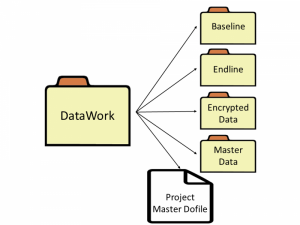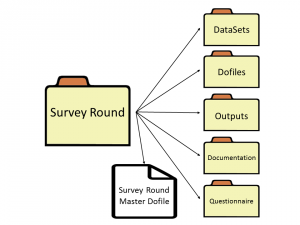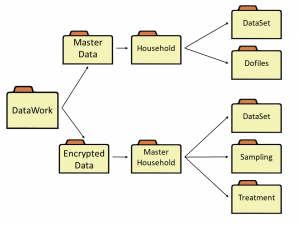DataWork Folder
A well-organized data folder reduces the risk for many types of errors. At DIME, we have a standardized folder structure. Some projects have special folder requirements and only use the folder set up as a starting point, but many resources created by DIME are easier to take advantage of if this template is followed. It takes a lot of work to reorganize a project folder, so we strongly recommend that projects follow our standard from the beginning. A poorly set up folder will have inefficiency consequences and increases the risk of errors over several years.
We have published a command called iefolder in our package ietoolkit that we have published on SSC. iefolder sets up the recommended folder structure described in this article for you.
Read First
- Do not set up these folders manually. iefolder is a Stata command that easily sets up and updates this folder structure for you.
Where should the DataWork folder be created?
Most project folders are shared across the project teams using DropBox, Box, or something similar. In this folder, there are different folders for project budget, government communications, etc. DIME's folder structure template assumes 'the DataWork' folder to be one of them.
See Image 1 on the right with an example of a Box/DropBox folder with three project folders. All three projects have a similar sub-folder structure, but in the image only one of the projects sub-folder structure is shown. The DataWork folder is highlighted with a red circle.
Anything related to the data of a project has a designated location inside this folder. This includes data-files, sampling and treatment assignment code, questionnaires, data collection documentation, analysis code, analysis output etc. This includes data collected by ourselves, both regular survey rounds and monitor data, and also includes other sources of data such as admin data or secondary data.
Inside the DataWork folder
Inside the DataWork folder there should only be folders and a master do-file or perhaps also other documentation that helps navigating those folders. The folder structure in the image is a template that we recommend for all projects, although we understand that some projects have special requirements and therefore will only use this as starting point. Everything described here is easily set up using the Stata command iefolder.
The DataWork folder should have a folder we call EncryptedData where files with sensitive data should be put and can be encrypted, a folder we call MasterData where we keep documentation and data sets that track the observations we are collecting data on, a project master do-file, and survey round folders where the data for each survey round is stored. The survey round folders can be organized into subfolders for complex projects with a large number of surveys. All of these items are explained below.
EncryptedData
This folder create a branch in the DataWork folder that can easily be encrypted using an encryption software like boxcryptor. Anything identifying or in any otherway sensitive data, should be saved in this folder. Note that while iefolder helps you create a folder called Encrypted Data when you set up the DataWork in the first place, iefolder does not encrypt it. Later, when creating either a new survey round or new unit of observation (Master Data) with iefolder, the command creates folders for each survey round or unit of observation in the EncryptedData folder where raw data, high frequency checks and other items likely to have identifying or other sensitive information should be stored.
MasterData
After the project folder is set up initially, there are two types of folders, neither of them yet created, where the data for the project should be stored. One type is Survey Rounds and this is where data in relation to a specific data collection is stored. This is explained in more detail below, but a survey round is typically baseline, endline etc. The other type that will be discussed here is the Master Data. A project need one master data set for each unit of observation used in the project, for example, households, students, teachers, firms, etc.
In a master data set we store information about all the observations we collect data on. This should be more than just the sample that we end up using in our data collections. This should also include observations in a census not sampled for the project or observations not in the sample that we still encounter in monitoring activities. This is important as we are sometimes needed to be able to identify observations that are not in our sample, not just the observations that are. In these master data folder we can track any time-invarient information that could be needed across our project, such as observation in sample, which assigned treatment status, monitoring information such as in treatment uptake, identifying information etc. The data sets where we store this information are called Master Data Sets.
When adding a new unit of observation using iefolder, folders are created both inside the encrypted branch of the DataWork folder and outside it. In the encrypted branch we can store any information, but the version of the master data set in the MasterData folder outside the encrypted branch should have all identifying information removed. The reason we have an decrypted version as well is that it is quicker to access and it can often be shared outside the research team.
Sampling and Treatment Assignment
The master data sets folder should also include all activities that is best practice to do directly on the main listing of all observations. The two best examples of such tasks in the context of Impact Evaluation is sampling and treatment assignment. This should never be done directly on census data or baseline data etc. Census data will be used for sampling, but the point here is that we always want to match the census data to the master data and check that it makes sense in relation to whatever data we have there already. After that quality control step, we can sample directly from the master data set knowing that the sample we randomize will make sense in relation to other data sources.
Project Master Do-File
The DataWork folder should also have a project master do-file. A master do-file is a do-file that runs other do-files needed to everything from cleaning to analysis and it also set same settings for all users making sure that everyone gets the same result. A very useful side effect of a master do-file running all other do-files is that it works as a map to where all files are located in the DataWork folder. If you are new to a project folder, always start by finding the master do-file.
The project master do-file sits in the DataWork folder, but each round folder has a round master do-file as well. The round master do-file has the same purpose but only for the files and folders associated with that round. A master do-file is also used to set up dynamic file paths so that multiple users can work from the same project folder shared over, for example, DropBox or Box. See the article on master do-files for more details.
Inside a Survey Round Folder
Baselines, Follow Up Surveys, Midlines, Endlines are all examples of a Survey Round. But other types of data sources also fits in Survey Rounds in this project folder template. Those types could be monitor data or admin data. Each survey round is a source of data. If that source is collected continuously (like admin data or secondary data as macro data over time) then only one survey round is needed, but data sources that are collected in stages (like household data collected in both baseline and later in endline) there should be one Survey Round created for each stage.
Each survey round should have it's own sub-folder inside the DataWork folder. This folder, the sub-folders discussed here and a round master do-file are created automatically if you use iefolder. For example - Inside the main data folder, you can have sub-folders like baseline, follow up 1, follow up 2, midline, endline, etc. See image 3 for an example.
Inside each Survey Round folder you have a master do file for that survey round as well as the following folders DataSets, Dofiles, Outputs, Documentation, and Questionnaire. You can create more folders that are unique to your project, but these are the standardized folders that iefolder creates for you.
See DataWork Survey Round for more details.
Survey Round Best Practices
Here are some best practices in relation to survey rounds folder organization:
Multiple Units of Observation in a Survey Round
If you have multiple units of observations in a survey round, for example farmers and village leaders, or students, teachers and schools, then you should create a survey round folder for each unit of observations for each round of data collection. For example, you would end up with one survey round folder called baseline_students, one called baseline_teachers and one called baseline_schools. iefolder gives you the option of creating a subfolder that wou could call baseline and create all baseline survey rounds baseline_students, baseline_teachers and baseline_schools in it. Note that each survey round needs to have a unique name across the project when using iefolder.
Sampling and Treatment Assignment
Sampling and Treatment Assignment folders have intentionally been left out from the survey round folders. Separate folders for those tasks has been created in the master data set folder as we strongly recommend that sampling and treatment assignment is done directly from the master data sets.
Monitor Data
Monitor data is data collected to understand the implementation of the assigned treatment in the field. Typically, survey round data helps us understand if any changes in the outcome variables under the duration of the project, and monitor data helps us understand how these changes are related to the intervention of our treatment. For example, monitor data could be data on who actually received the treatment and if the treatment was implemented according to the research design. Our analysis might be invalid if we do not have this information and base our analysis only on what was meant by the research team to happen. Monitor data helps us understand what is usually referred to as internal validity.
For the purposes of DIME's project folder template, Monitor Data should be treated as a survey round of its own. However, sometimes survey round data and monitor data are collected in the same data collection, and then it is not feasible to keep them separated.
Admin Data
Admin data is data that are usually collected by other actors, often for other purposes, but has been shared with the research team. It can be used both in the way survey round data is used in the analysis or as the way monitoring data can be used. For example, if the outcome variable the research team is trying to evaluate is measured in some other way then that is admin data we can use to measure change in outcome data. One example would be standardized test scores. We can often use the internal data our implementation partner uses as monitor data. That is one example when admin data is monitoring data. There are also many cases when the same admin data set is used for both purposes.
For the purposes of DIME's project folder template, Monitor Data should be treated as a survey round of its own.
Inside the Master Data Folder
Master Data Sets is the best tool to avoid errors related to using multiple sources of data for one project. Multiple survey rounds are in this sense different sources of data, so almost all impact evaluations use multiple sources of data (baseline and endline). A census made before a data collection should also be treated as a different source of data. Monitoring data and admin data combined with any other data are other examples. Therefore, master data sets should therefore be used in all projects and iefolder therefore creates the folder MasterData for Master Data Sets by default when the DataWork folder is created.
The Master Data Sets is a listing of all observations we have ever encountered in relation to this project (not just the observations we sampled). In this listing, we keep identifying information and the unique ID that we have assigned. We also keep time invariant information required at multiple stages of the research work. Examples are dummy for being sampled in baseline, categorical variable for treatment arm, dummy for correctly receiving the assign treatment arm etc.
Master Data Sets is more than just a folder. It is a methodology for internal research validity in a multi data set environment. See the Master Data Sets article for information both on how the master data set folder should be organized but also how it should be used for research quality purposes. One important motto is that if you do any merge (string or numeric) where the variable you merge on is not the uniquely and fully identifying ID variable, then one of the data set you are merging should always be a master data set. After you merged a data set to the master data set, you have that ID variable and you can safely merge that data set with any other data set that has also been merged towards the master data set.
There are two locations where Master Data Sets are stored. One location inside the encrypted branch of the DataWork folder. Here you can save a Master Data Set with identifying information. In not other data set than here will we have both the ID variable as well as identifying information. This is the key between the IDs that we use and the identity of the respondents. If this data set is shared publicly, then the identity of all of our respondents are revealed.
Back to Parent
This article is part of the topic Data Management




